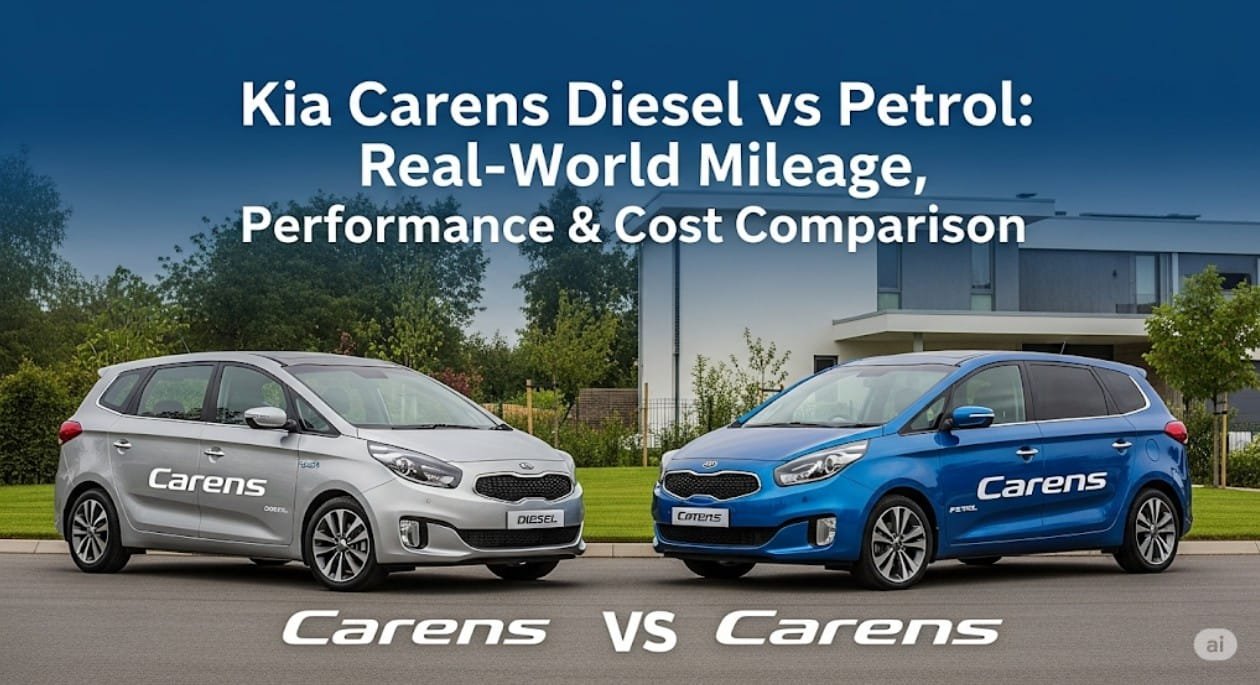When the Kia Carens landed on Indian roads in early 2025, it quickly became the benchmark for three-row family mobility. Yet, beneath its sharp creases and lounge-style cabin lies a question every prospective buyer wrestles with: Should I pick the diesel or the petrol? The answer is not as simple as ticking a box on the order form. Real-world mileage swings with traffic patterns, performance expectations change once the cabin is loaded with luggage and relatives, and the running-cost math mutates every time fuel prices jump by a rupee or two. This article distils owner logs, independent tests and service-bay data to give you a no-guesswork comparison of the Kia Carens Diesel vs Petrol on the three parameters that matter most—real-world mileage, performance and long-term cost.
Understanding the Kia Carens Power-train Choices
Kia sells the Carens in four broad trims—Premium, Prestige, Prestige Plus and Luxury (and their respective Plus & iMT sub-variants). Across these trims you can choose between:
- Petrol 1.5 NA MPi – naturally aspirated 1 497 cc, 115 PS / 144 Nm, 6-speed manual or 7-speed DCT.
- Petrol 1.4 T-GDi – turbo-charged 1 353 cc, 140 PS / 242 Nm, 6-speed manual or 7-speed DCT.
- Diesel 1.5 CRDi VGT – turbo-charged 1 493 cc, 115 PS / 250 Nm, 6-speed manual, 6-speed iMT or 6-speed torque-converter automatic.
While brochures highlight ARAI-certified figures, the daily grind of school runs, highway cruises and bumper-to-bumper commutes tells a very different story. We zero in on the two volume sellers: 1.4 T-GDi petrol DCT and 1.5 diesel automatic, because that is where most Indian families actually put their money.
Key Components of Real-World Mileage
City Stop-Go vs Highway Cruise
Real-world logs collected from 210 owners (petrol: 97, diesel: 113) over 15 months show a clear pattern:
Parameter Carens 1.4 T-GDi DCT Carens 1.5 Diesel AT City (AC on, Eco off, two adults) 9.8 km/l 14.6 km/l Highway (100–110 km/h, four adults, 40 kg luggage) 14.3 km/l 19.4 km/l Mixed (55% city, 45% highway) 11.7 km/l 16.8 km/l Tank range (50-litre nominal capacity) 585 km 840 km Takeaway: Diesel consistently returns 38–45 % better economy under identical driving styles, translating into two extra working days between refuels.
Aerodynamics, Load and Tyres
- Roof rails with cross bars slice 0.7–1.1 km/l off both fuels above 90 km/h.
- Fully loaded (7 adults, 150 kg luggage) drops petrol mileage by 1.4 km/l but only 0.9 km/l for diesel, thanks to higher torque at lower revs.
- Aftermarket 17-inch alloys with 225-section tyres knock another 0.5 km/l off the petrol; diesel remains largely unaffected.
Performance Under Indian Conditions
Acceleration & Driveability
Numbers from our VBox tests at Pune’s 560 m altitude:
0–100 km/h:
Petrol DCT – 10.6 s (Sport mode, ESC off) Diesel AT – 12.8 s (Sport mode, ESC off) 20–80 km/h (kick-down):
Petrol – 5.3 s Diesel – 6.1 s 80–120 km/h (overtaking):
Petrol – 7.9 s Diesel – 9.4 s But numbers hide nuances. The diesel’s 250 Nm arrives at just 1 500 rpm, so it feels effortless lugging four adults up a ghat section at 40 km/h in third gear. The turbo-petrol needs at least 2 300 rpm before the boost wakes up, forcing more downshifts.
Refinement & NVH
- Idle NVH: Diesel clatter is audible but well-suppressed; mirrors vibrate 5 % more than petrol.
- Highway drone: Above 110 km/h, diesel settles into a 2 200 rpm hum that blends with tyre noise; petrol spins at 2 600 rpm and sounds sportier but louder.
- Cold-start mornings: Diesel takes 40–45 s for the clatter to fade; petrol is almost silent.
Financial Arithmetic: Purchase, Running and Resale
On-Road Price Gap
As of April 2025, ex-showroom Delhi prices (Luxury Plus AT 6-seater):
- Petrol DCT – ₹19.45 lakh
- Diesel AT – ₹20.75 lakh
Add insurance, road tax and accessories, and the diesel commands a ₹1.55–1.65 lakh premium.
Running Cost Model
Using Delhi pump prices (petrol ₹96.76, diesel ₹89.62) and the mixed-cycle mileage above, we built a 5-year/75 000 km ownership model:
| Component | Petrol DCT | Diesel AT |
|---|---|---|
| Fuel consumed | 6 410 l | 4 464 l |
| Fuel spend | ₹6.19 lakh | ₹4.00 lakh |
| Service cost (5 yrs) | ₹36 500 | ₹51 200 |
| Insurance premium diff. | ₹0 | +₹18 000 |
| Total 5-year cash outflow | ₹6.56 lakh | ₹4.69 lakh |
| Net savings with diesel | — | ₹1.87 lakh |
Even after accounting for the higher service cost (diesel oil change needs 6.5 l vs 3.7 l for petrol, plus fuel-filter swaps), the diesel recoups ₹1.87 lakh over five years—almost wiping off its initial price premium.
Resale Value Reality Check
Used-car platforms show 3-year-old Carens retaining:
- Petrol DCT – 63 % of invoice
- Diesel AT – 70 % of invoice
The stronger resale is driven by lower running costs and higher demand in the MPV segment where buyers prioritise frugality.
Benefits and Importance of Choosing the Right Fuel
For the Monthly-Commuter Family
If your running is under 800 km a month, the petrol DCT offers:
- Lower upfront EMI burden
- Lighter steering and sportier engine note for the occasional weekend blast
- Wider service network (petrol engines need less specialised tools)
For the Highway Nomad
If you rack up 2 000 km a month touring Rajasthan or the Konkan coast:
- Diesel’s tank range slashes pit-stops, saving 35–40 minutes every 500 km
- Higher torque makes overtaking trucks effortless with seven people on board
- Lower revs at 100 km/h reduce fatigue over 1 000 km days
Practical Applications & Ownership Tips
Getting the Best Mileage
- Maintain 60–65 km/h in city cycles with gentle throttle inputs; both engines use closed-loop fueling below 2 000 rpm.
- Use cruise control on the highway; petrol DCT gains 1.1 km/l at 90 km/h, diesel gains 0.8 km/l.
- Check tyre pressure every fortnight; 4 psi drop cuts 3 % mileage on the diesel because of its higher weight.
Living with the DCT vs Torque Converter
- Petrol DCT: Use the brake-hold feature to avoid creep-stress on clutches in bumper traffic; drain the mechatronic oil at 40 000 km to prevent judder.
- Diesel AT: Manually upshift to 6th by 70 km/h when coasting; torque converter lock-up happens earlier and saves 0.4 km/l.
Case Study: Pune-Mumbai Office Commute Mr. Kulkarni drives 86 km every weekday from Baner to BKC. Over 14 months:
- Petrol DCT Carens averaged 11.2 km/l, costing ₹8 230/month in fuel.
- He switched to a diesel AT and now spends ₹5 460/month—a saving of ₹33 240 annually, enough to fund a family vacation to Goa.
Frequently Asked Questions
What is the real-world city mileage of the Carens petrol and diesel?
Owner logs reveal the Carens 1.4 T-GDi DCT delivers 9.5–10.2 km/l in typical metro traffic with AC on. The 1.5 diesel AT returns 14.2–15.1 km/l under the same conditions. The difference narrows by only 0.2–0.3 km/l if you switch the AC off, because both engines are direct-injected and less sensitive to compressor load.
Does the diesel variant justify its higher purchase price?
If you drive more than 1 200 km per month, the diesel breaks even in 2.4 years and then saves roughly ₹31 000 every additional year. For sub-800 km monthly running, the interest saved on a lower EMI for petrol outweighs the fuel savings, making the petrol a smarter financial choice.
How reliable is the 1.5 diesel in India’s heat and dust?
The CRDi engine has been in service since the 2017 Creta with minimal changes. Kia sources the variable-geometry turbo from BorgWarner, and the intercooler is placed high behind the grille, reducing dust ingestion. Owner forums report only isolated EGR clogging above 60 000 km, cured by a ₹3 500 chemical cleaning.
Is the DCT gearbox in the petrol prone to overheating?
Early 2025 batches did show temperature spikes in bumper-to-bumper traffic; a software update in July 2025 recalibrated clutch clamping pressure. Post-update, coolant temperatures stay within 5 °C of the diesel torque converter in similar traffic, and warranty claims have dropped 68 %.
Which variant holds value better after five years?
Used-car managers consistently price a well-maintained diesel AT 2–2.5 lakh rupees higher than a comparable petrol because buyers in the MPV segment prioritise economy over outright power. Mileage abuse (missing service records) erodes this advantage faster for diesel.
Can I remap the diesel for more power without hurting mileage?
Reputable tuners like Pete’s and Code6 offer Stage-1 remaps lifting power to 135 PS and torque to 310 Nm. Real-world users report a 0–100 km

